By Doug Winter – RareGoldCoins.com ……
CoinWeek Content Partner
Early US gold is defined as quarter eagles, half eagles, and eagles struck between 1795 and 1834. These issues have long been very popular with collectors. They are mostly collected by type, but a few well-heeled individuals specialize in date sets of specific denominations.
As a dealer who handles more than his fair share of early gold, I’d like to share five brief observations which I have made relative to the current coin market.
Grading Inconsistencies Lead to Pricing Anomalies
There are two grade ranges–AU58 to MS61 and MS63 to MS64–that show the greatest degree of inconsistency when it comes to grading. In both of these ranges, there are certain coins that, while graded lower, are given higher values by the market than higher-graded examples due to superior eye appeal. Let me give you an example.
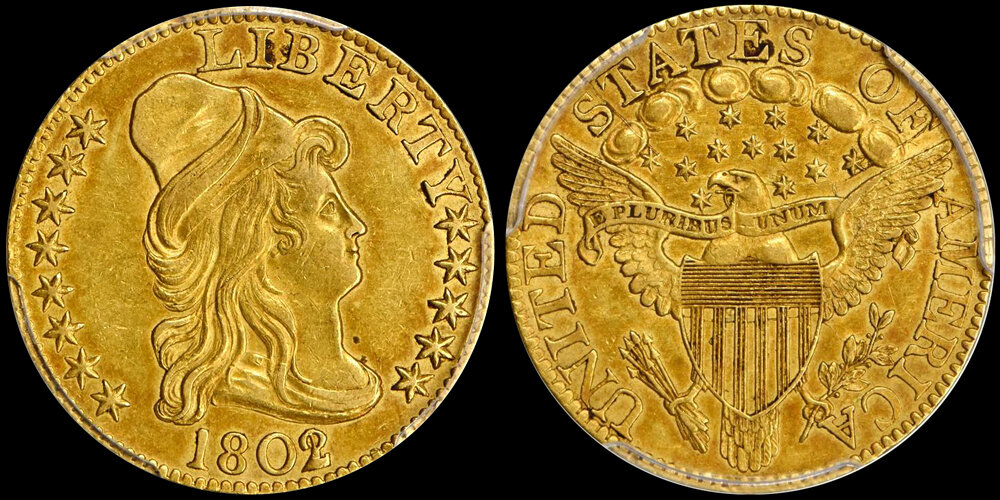
1802/1 $5.00 PCGS AU58 CAC. All images courtesy Stack’s Bowers Galleries unless otherwise noted
In their 11/2019 auction, Stack’s Bowers sold an 1802/1 half eagle in PCGS/CAC AU58 for $15,600 USD. The most recent APR for this date in PCGS MS62 is $16,806 set by Heritage 4/2021: 4584. And to drill down a little further, the most recent APR for this date in PCGS MS61 is $12,925 from Legend’s October 2020 sale. While admittedly a small sample size, this shows that the market feels that a nice CAC AU58 is worth as much or potentially even more than a so-so MS62.
I think this will continue although there will be individual coins that break the mold. Examples would include CAC-approved coins that appear to be just average for the grade, and very PQ non-CAC coins that will sell for premium prices due to superior eye appeal.
Specific Issues I Never See Offered
Let me preface this by stating that this list doesn’t include mega-rarities like the 1815 half eagle. It focuses on scarce-to-rare issues that are almost never seen with the originality that I strive for with the coins that I purchase for resale.
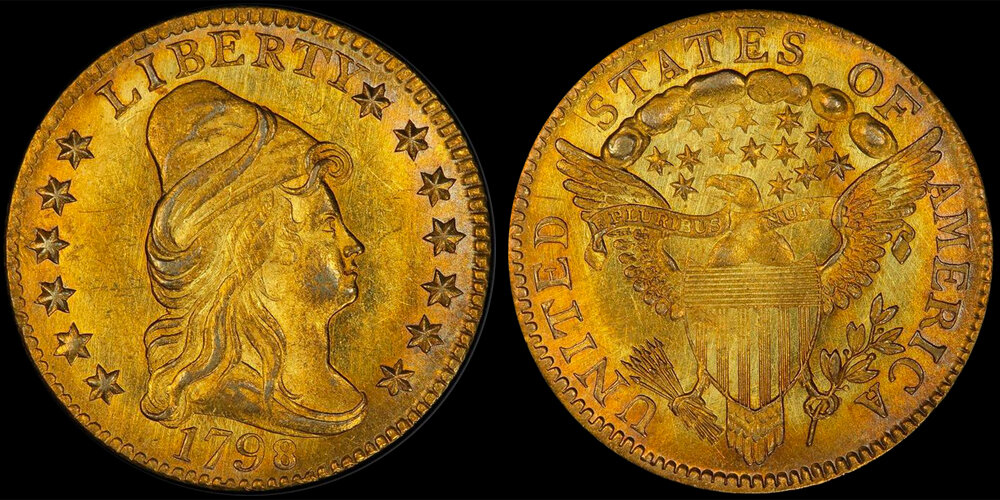
1798 CLOSE DATE $2.50 PCGS MS65, EX: Pogue
In the quarter eagle denomination, two dates that are almost never seen with my “look” are the 1797 and the 1798. With the exception of the Pogue II: 1118 coin (graded AU58 by PCGS and sold for $152,750), there have been no decent 1797 quarter eagles sold at auction since July 2009 when Stack’s offered a PCGS AU53. Since 2008, there have been just two nice 1798 Close Date quarter eagles sold and one was the spectacular Pogue II: 1119 Gem (graded MS65 by PCGS), which brought $763,750. The slightly more available 1798 Wide Date has also proven elusive with just two nice examples offered since the beginning of 2012: the Newman V: 3194 coin, graded AU58+ by NGC, and the PCGS/CAC MS61, which brought $129,250 as Heritage 2016 FUN: 5528.
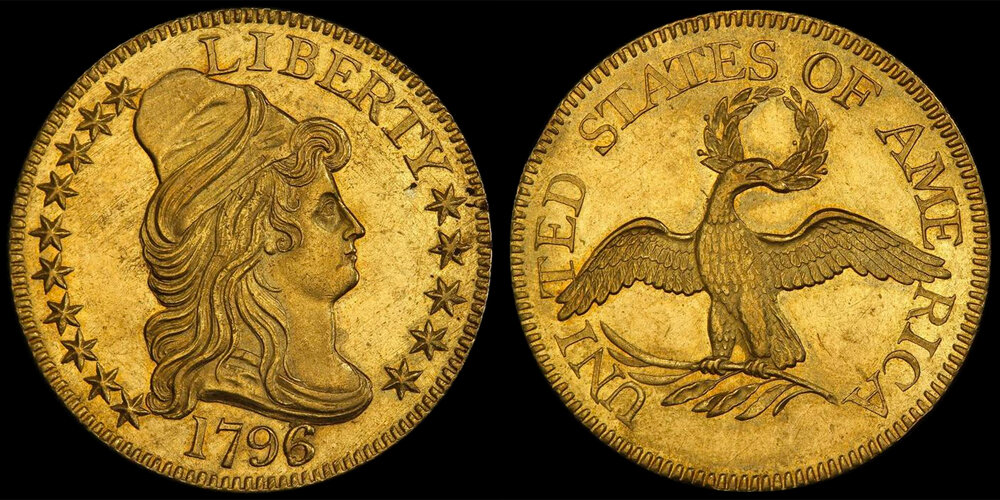
1796/5 $5.00 PCGS MS62+, Pogue Collection
In the half eagle denomination, two dates that are almost never seen with my look are the 1796/5 and the 1808/7. Since the start of 2014, I can recall just two or three examples of the 1796/5 issue that I really liked. The Pogue II: 2071 example, graded MS62+ by PCGS, was nice (and it brought $152,750). I also appreciated the above-average eye appeal of the PCGS AU58 which Stack’s sold in March 2017 for $73,348 and the PCGS MS62 which realized $180,000 in the Heritage CSNS sale in 2018.
For the 1808/7, I can recall just one really nice collector grade example which I’ve seen in the last five-plus years: a PCGS AU58 that brought $18,800 as Stack’s 2013 ANA: 4478.

1798/7, STARS 7X6, PCGS MS61, Pogue Collection
In the eagle denomination, an obvious inclusion to this list is the 1798/7, Stars 7×6. By far the nicest I have seen was the Pogue II: 2097 coin, graded MS61 by PCGS, which brought a record-setting $705,000. The only other really nice piece to sell in the last decade was the Eliasberg PCGS AU58 coin, which realized $352,500 in the Stack’s Bowers 2016 ANA auction.
The 1804 is the other issue that I rarely see with its originality (mostly) intact. I really liked the PCGS/CAC AU55 that sold for $90,000 in the Heritage 2019 FUN auction, but you’d have to go back to September 2015 to find a better piece – which was, of course, Pogue II: 2105, graded MS63+ by PCGS, which realized $440,625.
The Underappreciated Capped Bust/Large Diameter Quarter Eagle
This type was struck for five years and just one date—the 1825—can be described as “reasonably easy” to locate. The other four have proven very elusive and only a small number of nice coins have become available in the last decade-plus.
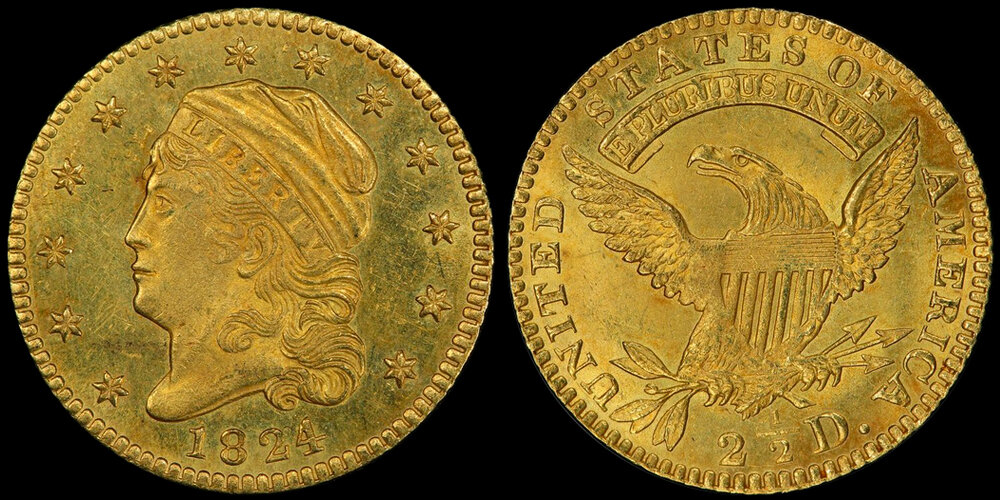
1824/1 $2.50 PCGS MS64, Courtesy PCGS CoinFacts
Let’s look at one specific date, the 1824/1. Despite a low mintage of 2,600, this issue is likely the second-most-available of this type after the 1825. There have been just three nice pieces sold at auction since the beginning of 2011: a PCGS/CAC MS61 that realized $40,250 in 2012, the PCGS MS63 Pogue II coin that sold for $70,500 in 2015, and the lovely PCGS MS64 from the McCoy Family Collection that was bid up to $91,063 (a record price for this issue) in 2016.
If you want to own a nice circulated 1824/1, you’ll have to be patient. CAC has approved nine total for this issue with one in VF35, one in EF45, and three in AU58 with the other four in Uncirculated. Interestingly, CAC has currently approved only 39 coins for the entire type, with 16 of these dated 1825.
Adjustment Marks
Up through the Capped Bust Left type (production of which ended in 1812), adjustment marks are reasonably common on early gold. These were caused by mint employees scraping off planchets that were overweight to bring them to specifications.
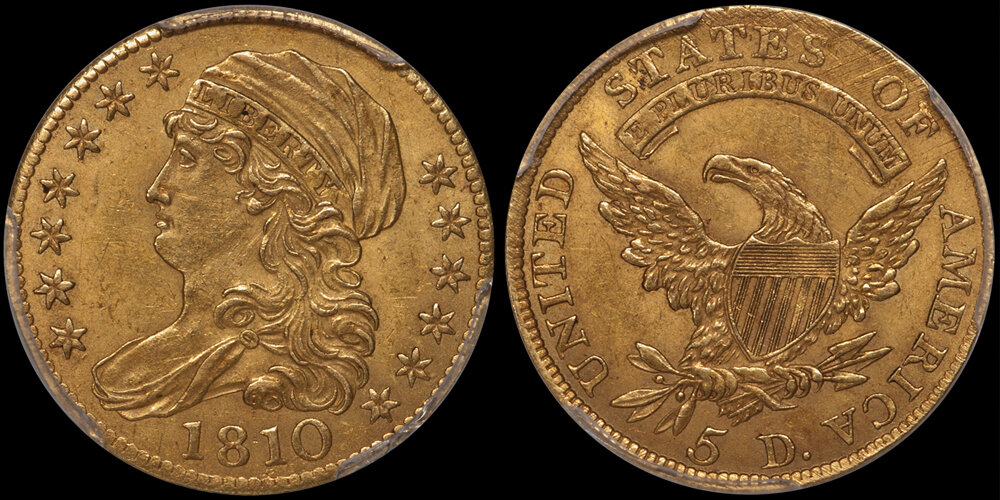
1810 LARGE DATE $5.00 PCGS MS62+ CAC. Adjustment marks on reverse
I generally do not mind adjustment marks as long as they are relatively unobtrusive. In my opinion, a few minor adjustment marks on the reverse are no big deal, nor are some placed at the periphery of the obverse.
There are instances where adjustment marks do bother me and I will pass on a coin because of them. Most of the time it is due to them either being especially deep and/or being located in a prime focal point – i.e., the cheek of Liberty.
I would like to see the grading services designate early US coins (gold and silver) that have readily visible adjustment marks. The market will decide if such coins should be penalized from a value standpoint.
What is it About 1814/3 Half Eagles and Deep Reddish-Gold Color?
When you’ve handled (and viewed) as much early gold as I have, you tend to notice certain peculiarities about the coins. One thing that comes to mind is the odd coloration seen on a number of 1814/3 half eagles.

1814/3 $5.00 PCGS AU55
This is a scarce and underappreciated issue that is typically seen in AU55 to MS62 grades. Many have been processed over the years and now have bland coloration. But I have seen a decent number, perhaps as many as 10, with very unusual but 100% natural deep reddish-gold or fiery orange-gold color. These hues are unlike any other that I can recall on any early US gold coin.
I’m guessing that the reason for this is that a certain number of 1814/3 half eagles were made from gold that had an unusual source. It is possible that these were made from reclaimed foreign coins or, less likely, from a domestic location that supplied gold that contained a very high percentage of copper.
Whatever the reason, these 1814/3 half eagles are really pretty and worth a strong premium in my opinion.
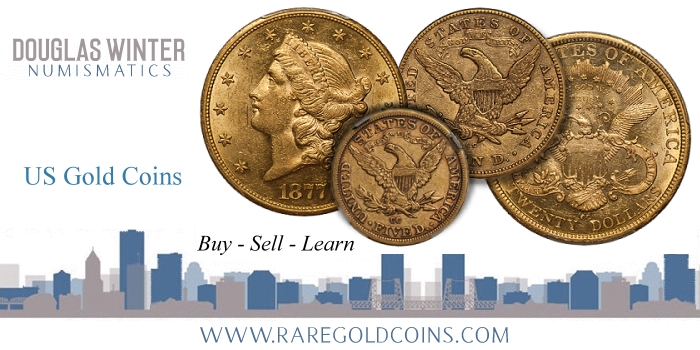
* * *
About Doug Winter
 Doug has spent much of his life in the field of numismatics; beginning collecting coins at the age of seven, and by the time he was 10 years old, buying and selling coins at conventions in the New York City area.
Doug has spent much of his life in the field of numismatics; beginning collecting coins at the age of seven, and by the time he was 10 years old, buying and selling coins at conventions in the New York City area.
In 1989, he founded Douglas Winter Numismatics, and his firm specializes in buying and selling choice and rare US Gold coins, especially US gold coins and all branch mint material.
Recognized as one of the leading specialized numismatic firms, Doug is an award-winning author of over a dozen numismatic books and a recognized expert on US Gold. His knowledge and an exceptional eye for properly graded and original coins have made him one of the most respected figures in the numismatic community and a sought-after dealer by collectors and investors looking for professional personalized service, a select inventory of impeccable quality, and fair and honest pricing. Doug is also a major buyer of all US coins and is always looking to purchase collections both large and small. He can be reached at (214) 675-9897.
Doug has been a contributor to the Guidebook of United States Coins (also known as the “Redbook”) since 1983, Walter Breen’s Encyclopedia of United States and Colonial Coins, Q. David Bowers’ Encyclopedia of United States Silver Dollars and Andrew Pollock’s United States Pattern and Related Issues
In addition, he has authored 13 books on US Gold coins including:
- Gold Coins of the New Orleans Mint: 1839-1909
- Gold Coins of the Carson City Mint: 1870 – 1893
- Gold Coins of the Charlotte Mint: 1838-1861
- Gold Coins of the Dahlonega Mint 1838-1861
- The United States $3 Gold Pieces 1854-1889
- Carson City Gold Coinage 1870-1893: A Rarity and Condition Census Update
- An Insider’s Guide to Collecting Type One Double Eagles
- The Connoisseur’s Guide to United States Gold Coins
- A Collector’s Guide To Indian Head Quarter Eagles
- The Acadiana Collection of New Orleans Coinage
- Type Three Double Eagles, 1877-1907: A Numismatic History and Analysis
- Gold Coins of the Dahlonega Mint, 1838-1861: A Numismatic History and Analysis
- Type Two Double Eagles, 1866-1876: A Numismatic History and Analysis
Finally, Doug is a member of virtually every major numismatic organization, professional trade group and major coin association in the US.




